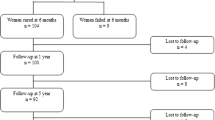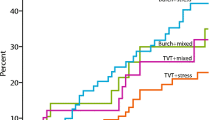Abstract
Introduction and hypothesis
The aim was to evaluate the long-term cure rates and the late complications of the tension-free vaginal tape (TVT).
Methods
One hundred and forty-seven women with stress incontinence underwent surgery at our clinic between 1994 and 1997. At the time of follow-up, 128 were alive, 104 attended an objective evaluation at the clinic, while 20 women were contacted by telephone for an extensive interview. Eighty-four percent were assessed in a retrospective study 10–13 (11.5) years post-operatively. The evaluation included a stress test and, if this test was positive, also a 24-h pad-weighing test, the same questionnaire about urinary symptoms as that used pre-operatively and a visual analogue scale.
Results
The objective cure rate was 84%. The subjective cure rate was 77%, while 18% had improved. Ninety-four percent of the patients were satisfied with the surgical result. No late adverse effects of the operation were found.
Conclusions
The TVT procedure is effective and safe for more than 10 years.


Similar content being viewed by others
References
Liapis A, Bakas P, Creatsas G (2008) Long-term efficacy of tension-free vaginal tape in the management of stress urinary incontinence in women: efficacy at 5- and 7-year follow-up. Int Urogynecol J 19:1509–1512
Nilsson CG, Falconer C, Rezapour M (2004) Seven-year follow-up of tension-free vaginal tape procedure for treatment of urinary incontinence. Obstet Gynecol 104:1259–1262
Nilsson CG, Palva K, Rezapour M, Falconer C (2008) Eleven years prospective follow-up of the tension-free vaginal tape procedure for treatment of stress urinary incontinence. Int Urogynecol J 19:1043–1047
Ulmsten U, Henriksson L, Johnsson P, Varhos G (1996) An ambulatory surgical procedure under local anesthesia for treatment of female urinary incontinence. Int Urogynecol J Pelvic Floor Dysfunct 7(2):81–85
Olsson I, Kroon U (1999) A three-year postoperative evaluation of tension-free vaginal tape. Gyncol Obst Invest 48:267–269
Debodinance P, Delporte P, Engrand J, Boulogne M (2002) Tension-free vaginal tape (TVT) in the treatment of urinary stress incontinence: 3 years experience involving 256 operations. Eur J Obst Gynecol Reprod Biol 105:49–58
Chene G, Amblard J, Tardieu AS, Escalona JR, Viallon A, Fatton B, Jaquetin B (2007) Long-term results of tension-free vaginal tape (TVT) for the treatment of female urinary stress incontinence. Eur Obstet & Gynecol Reprod Biol 134:87–94
Lee K-S, Choo M-S, Doo CK, Han D-H et al (2008) The long-Term (5-Years) Objective TVT Success rate does not depend on predictive factors at multivariate analysis. A multicentre retrospective study. Eur Urol 53:176–183
Deffieux X, Donnadieu AC, Porcher R, Gervaise A, Frydman R, Fernandez H (2005) Long-term results of tension-free vaginal tape for female urinary incontinence: follow up over 6 years. Int J Urol 14(6):521–526
Holmgren C, Nilsson S, Lanner L, Hellberg D (2005) Long-term results with tension-free vaginal tape on mixed and stress urinary incontinence. Obstet Gynecol 106(1):38–43
Kjölhede P (2005) Long-term efficacy of Burch colposuspension: a 14-year follow-up study. Acta Obstet Gynecol Scand 84:767–772
Allahdin S, Harrild K, Warraich QA, Bain C (2008) Comparison of the long-term effects of simple total abdominal hysterectomy with transcervical endometrial resection on urinary incontinence. Br J Obstet Gynecol 115(2):199–204
Robinsson D, Cardozo L (2003) Risk factors for urinary incontinence in women. J Br Menopause Soc 9(2):75–79
Holmgren C, Nilsson S, Lanner L, Hellberg D (2007) Frequency of de novo urgency in 463 women who had undergone the tension-free vaginal tape (TVT) procedure for genuine stress urinary incontinence-A long-term follow-up. Eur J Obstet Gynecol Reprod Biol 132(1):121–125
Cardozo L, Lose G, McClish D, Versi E (2004) A systematic review of effects of estrogens for symptoms suggestive of overactive bladder. Acta Obstet Gynecol Scand 83:892–897
Zullo MA, Plotti F, Calcagno M, Palaia I, Muzii L et al (2005) Vaginal estrogen therapy and overactive bladder symptoms in postmenopausal patients after a tension-free vaginal tape procedure: a randomized clinical trial. Menopause 12(4):421–427
Kuuva N, Nilsson CG (2002) A nationwide analysis of complications associated with the tension-free vaginal tape. Acta Obstet Gynecol Scand 81:72–77
Karram MM, Segel JL, Vassallo BJ, Kleeman SD (2003) Complications and untoward effects of the tension-free vaginal tape procedure. Obstet Gynecol 101(5):929–932
Conflicts of interest
None.
Author information
Authors and Affiliations
Corresponding author
Rights and permissions
About this article
Cite this article
Olsson, I., Abrahamsson, AK. & Kroon, UB. Long-term efficacy of the tension-free vaginal tape procedure for the treatment of urinary incontinence. Int Urogynecol J 21, 679–683 (2010). https://doi.org/10.1007/s00192-009-1083-7
Received:
Accepted:
Published:
Issue Date:
DOI: https://doi.org/10.1007/s00192-009-1083-7




